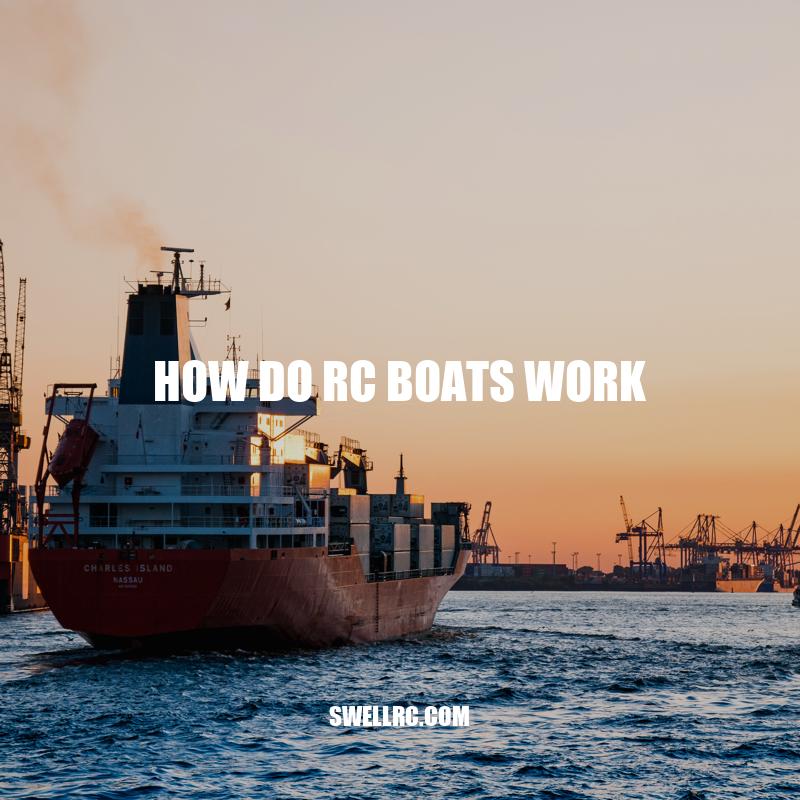How Do RC Boats Work? A Comprehensive Guide.
RC boats, or radio-controlled boats, are miniature versions of real-life boats that are powered by remote control. These vessels come in all shapes, sizes, and styles, from simple toy boats to advanced competition-grade models. RC boats operate using a combination of electricity, gas, or wind power, depending on the design and the intended use. The purpose of this article is to explain how RC boats work, including the various components that make up a standard model and the fundamental principles behind their operation. Understanding how RC boats work is important for anyone who wants to enjoy this hobby safely and get the most out of their vessel. It’s important to know the basic mechanics of an RC boat to avoid accidents while operating one. So, let’s dive into the anatomy and operation of RC boats, from power sources to safety protocols.
Anatomy of RC Boats
RC boats are made up of various components that interact to power the boat. These include:
- Hull: This determines the speed and performance of the boat in the water.
- Motor: The motor provides the power to the propeller to move the boat through the water.
- Propeller: The propeller converts the motor’s rotary motion into forward thrust to propel the boat forward.
- Battery: This provides the power required to run the motor and operate the remote control.
- Remote Control: This is used to govern the operation of the boat, including its speed, direction, and steering.
The shape and design of the hull can greatly impact the performance of the boat in the water. Different hull designs allow for different types of RC boats suited for different purposes, and there are models of even greater complexity that include features like water cooling system and reverse-thrust. The size of the motor determines the speed and acceleration of the boat, with bigger motors being used for bigger boats. The battery system used can either be built-in or modular, depending on the design of the boat. You might need to invest in a high-quality battery for your rc boat to enhance your overall experience. The remote control unit is used to govern the operation of the boat, including its speed, direction, and steering. Knowing how each of these components interacts is vital in understanding how RC boats work.
What are the components of an RC boat?
The components of an RC boat include:
- Hull
- Motor
- Propeller
- Battery
- Speed controller
- Radio receiver
- Servo(s)
- Transmitter
These components work together to control the movement and speed of the boat. If you’re looking to buy an RC boat or any related components, check out websites like Horizon Hobby or Tower Hobbies.
Electric RC Boats
Electric RC boats are becoming increasingly popular due to their simplicity and low cost. Some of the key features of electric RC boats include:
- Battery power: Electric RC boats operate on a rechargeable battery pack, which eliminates the need for fuel or gas.
- Simplicity: With fewer components than gas-powered models, electric RC boats are easier and cheaper to maintain.
- No noise pollution: Electric motors are quiet when compared to gas or nitro-powered engines, so they make for a more peaceful RC boating experience.
Electric RC boats offer a great variety of models to choose from, including simple beginner models to advanced racing boats. These types of boats have a shorter operational range than gas-powered boats, but they compensate for it with faster speeds and lower noise. A wide range of electrical motors is available, and they can range from basic brushed motors to high-quality brushless motors. Brushless motors offer better efficiency and less wear and tear than standard brushed motors.
| Pros | Cons |
|---|---|
| Easier and cheaper to maintain than gas-powered boats | Less operational range than gas-powered boats |
| Faster speeds and lower noise pollution | Require charging between uses |
| Wide variety of models available | Less efficient than nitro models |
As technology continues to improve, electric RC boats will become more affordable, reliable and efficient. This presents an excellent opportunity for anyone who wants to enjoy an RC boating experience without significant costs or complications.
Gas-Powered RC Boats
Gas-powered RC boats are the preferred choice of serious RC boaters due to their speed, power, and ability to run for extended periods. Some of the key features of gas-powered RC boats include:
- Powerful engines: Gas-powered boats can reach high speeds, and their engines last longer than electric motors.
- Long run time: With large fuel tanks, gas boats can run for hours before needing to refuel.
- Adjustable: These boats have a tunable carburetor, which allows the user to adjust the fuel mixture to optimize the engine’s performance.
Gas-powered RC boats can reach speeds of over 50 mph, making them a popular option for racing enthusiasts. They are suitable for large bodies of water, and they also offer a wide variety of models to choose from for hobbyists. As with other types of boats, there are pro and cons to consider with gas-powered models:
| Pros | Cons |
|---|---|
| Fast and powerful | Require more maintenance |
| Longer runtime than electric models | Loud and noisy operation |
| Adjustable for optimal performance | Cost more than electric models |
It’s worth noting that using gas boats can be more expensive than other types of RC boats. As a result, many gas boat enthusiasts prefer to invest in high-quality models that offer superior performance and longer runtimes. To get the most out of a gas-powered RC boat, it’s essential to keep up with its maintenance schedule and perform regular checks to ensure that all components are running efficiently.
Are Boats Gas Powered?
Yes, many boats are powered by gasoline. However, there are also boats that run on diesel fuel, electric batteries, or even solar power. It is important to know what type of fuel your boat requires before purchasing or operating it. Some popular boat brands that utilize gas-powered engines include Yamaha, Mercury, and Honda. For more information on boat engines and fuel types, check out websites like boatus.com or boatdesign.net.
Sailboats
Sailboats are unique among RC boats in that they rely on the wind to propel them through the water. Here are some of the features of RC sailboats:
- Sails: Made from polyester or nylon, sails are adjustable to catch the wind and propel the boat forward.
- Ballast: These boats have a keel ballast that provides stability and prevents capsizing.
- Size: RC sailboats come in various sizes, from small pond boats to large ocean-going models.
RC sailboats can be enjoyable to operate, but they require some skill to control them effectively. Controlling a sailboat using only the wind direction takes practice, especially when dealing with windy weather. Sailboats are best suited for larger bodies of water where the wind can produce the desired effect. Here are the pros and cons of RC sailboats:
| Pros | Cons |
|---|---|
|
|
|
|
|
|
Sailboats enthusiasts can find different models and sail sets on popular marketplaces such as Amazon, eBay, and other key hobby stores. It is essential to read the specifications to ensure that you match the boat’s size to the body of water you intend to sail. It’s worth noting that some RC race sailboats are available and built to specification to compete in organized events.
What is a Sailboat Used For?
Sailboats are vessels that use wind power to navigate the open water. There are a variety of ways that sailboats can be used, including:
- Recreational sailing
- Cruising to explore new places
- Racing competitively
- Fishing
- Transporting goods or people
Sailboats can range from small, single-person boats to large, luxurious yachts. They are popular with people who enjoy spending time on the water and sailing enthusiasts.
If you are interested in learning more about sailboats or purchasing one for yourself, there are many resources available online. Websites like BoatTrader and YachtWorld offer listings for new and used sailboats, while forums such as SailNet provide a community for sailors to share information and experiences.
RC Boat Safety
While operating an RC boat is an enjoyable hobby, it can be dangerous if not done safely. Here are some general safety tips to keep in mind while operating RC boats:
- Wear a life jacket: Always wear a personal flotation device (PFD) when operating an RC boat.
- Designated areas: Only operate RC boats in designated areas, such as local ponds or lakes.
- Be aware of others: If operating around others, ensure that people are out of the way before starting the boat.
- Beware of motors: Boat propellers can be dangerous if they come into contact with skin or clothing, so always ensure the motor is off before handling the boat.
- Pay attention to the weather: Operating boats in windy or choppy conditions can be risky, and boats can quickly capsize or flip over.
In addition to general safety tips, it’s essential to know how to handle different scenarios while operating an RC boat. Here are some common scenarios and how to handle them:
- Boat flips over: If your boat flips over, turn off the motor immediately and retrieve the boat. Empty the water, dry off electronics, and ensure everything is properly secured before continuing to operate.
- Battery failure: If the battery dies, immediately steer the boat to the shore using the rudder, being mindful of any other boats in the area.
- Collision with other boats: If your boat collides with another, immediately turn off the motor and retrieve the boat. Check for damage and ensure that all components are working correctly before continuing to operate.
There are plenty of websites online where enthusiasts can find more information on RC boat safety. The U.S. Coastguard provides comprehensive advice on boating safety, which can be applied to any RC boat. As for websites, RC groups and forums such as RC Groups, RC Universe, and RC Driver provide tips, tricks, and advice for safely operating your RC boat.
How does RC boat work?
RC (radio-controlled) boats are boats that are controlled remotely via radio signals. Here’s how they work:
- A transmitter sends commands to the receiver on the boat via radio waves.
- The receiver then translates those signals into action, such as moving the rudder or propeller.
- The boat’s motor and steering system respond accordingly.
- The RC boat can now be controlled remotely by the operator.
If you’re interested in purchasing an RC boat or learning more about how they work, there are many websites and retailers that offer information and products.
Conclusion
Operating an RC boat can be a fun and exciting hobby, but it’s crucial to understand how these boats operate before setting sail. In this guide, we have covered the three main types of RC boats: electric, gas, and sailboats, and explained their unique features, advantages, and drawbacks. We also highlighted the importance of safety when operating these boats and provided essential safety tips to ensure a safe and enjoyable experience. Remember to wear a PFD, operate in designated areas, avoid people and avoid windy or choppy conditions when using your RC boats.
There are plenty of resources available to help enthusiasts learn more about RC boats and how to operate them safely. From online forums to YouTube channels, there’s no shortage of information out there. Whether you’re a seasoned veteran or new to the world of RC boats, staying informed and taking safety precautions is the key to a successful and enjoyable experience. So, grab your RC boat, head to the water, and enjoy the ride!



